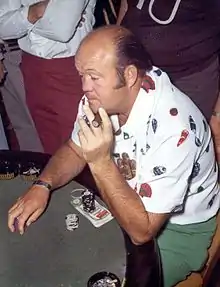Puggy Pearson
Walter Clyde "Puggy" Pearson (January 29, 1929 – April 12, 2006) was an American professional poker player. He is best known as the 1973 World Series of Poker Main Event winner.[1]
| Puggy Pearson | |
|---|---|
 Puggy Pearson in the 1974 World Series of Poker | |
| Nickname(s) | Puggy |
| Residence | Las Vegas, Nevada |
| Born | January 29, 1929 Adairville, Kentucky |
| Died | April 12, 2006 (aged 77) Las Vegas, Nevada |
| World Series of Poker | |
| Bracelet(s) | 4 |
| Money finish(es) | 9 |
| Highest ITM Main Event finish | Winner, 1973 |
Early years
Pearson was born and raised in Tennessee in a family with nine siblings. He got his nickname "Puggy" from a childhood accident that left him with a disfigured nose at the age of twelve.[2] He dropped out of school in the fifth grade, and at the age of 17, he joined the United States Navy, where he served three terms. He strengthened his skills at poker and gambling while in the Navy.[3]
Professional poker
Prior to 1949, all poker games were cash games; a player could cash out his chips and leave at any time. Pearson originated the idea of a freezeout tournament and shared his idea with fellow gambler "Nick the Greek" Dandolos in the early 1950s. Dandalos later brought the idea to legendary casino owner Benny Binion. After further urging by Pearson, Amarillo Slim, and Doyle Brunson, all of whom felt that such a tournament would create great side (cash) game action, Binion founded the World Series of Poker in 1970. Pearson participated in the first World Series of Poker that year along with Amarillo Slim, Doyle Brunson, Sailor Roberts, Crandell Addington, and Carl Cannon.[4]
Pearson won his first World Series of Poker (WSOP) bracelet in the 1971 Limit Seven-Card Stud preliminary event.[5] In 1973, he won two preliminary events in the WSOP. In the same World Series, Pearson won the Main Event when his A♠ 7♠ defeated Johnny Moss's K♥ J♠.[6] With the Main Event victory, he became the first player in WSOP history to win three events in a single year. This record has since been matched by five others. He won four bracelets, two of which were in seven-card stud and two of which were No limit hold'em.[7]
Pearson was known as a man who would always seek out the biggest game in town, whether it was in the poker room or on the golf course. He owned a RV, which he called the Roving Gambler, with this painted on the side: "I'll play any man from any land any game he can name for any amount I can count, provided I like it."[8]
Pearson was inducted into the Poker Hall of Fame in 1987.[9]
He was also infamously abusive to casino employees, throwing cards at dealers, berating floor persons and not tipping service staff.
World Series of Poker Bracelets
| Year | Tournament | Prize (US$) |
|---|---|---|
| 1971 | Limit Seven-Card Stud | $10,000 |
| 1973 | $10,000 No Limit Hold'em World Championship | $130,000 |
| 1973 | $1,000 No Limit Hold'em | $17,000 |
| 1973 | $4,000 Limit Seven-Card Stud | $32,000 |
Notes
- "Famous Poker Player Biographies & History". Mac Poker Online.
- "Men of Action: Walter Clyde "Puggy" Pearson - Poker News". Card Player. Retrieved November 29, 2018.
- "Legend of Poker: Walter Clyde 'Puggy' Pearson 1929-2006". Poker News. Retrieved November 29, 2018.
- "World Series of Poker: A Retrospective: 1970 Summary". UNLV. Retrieved November 29, 2018.
- "2nd World Series of Poker (WSOP) 1971 - Limit 7 Card Stud - Event 1 - Poker Tournaments - Results". CardPlayer Magazine. Retrieved November 30, 2018.
- "Poker tournament pioneer 'Puggy' Pearson dies". Las Vegas Sun. Retrieved November 29, 2018.
- "WSOP NEWS: 37 Puggy Pearson". WSOP. Retrieved November 29, 2018.
- "A History of the World Series Of Poker: - Puggy "The Roving Gambler" Pearson (1973)". PartyPoker. June 17, 2013. Retrieved November 29, 2018.
- ""Puggy" Pearson, Poker Hall of Famer, Has Died - Poker News". Card Player. Retrieved November 29, 2018.
- Allan, Elkan. Walter 'Puggy' Pearson, The Guardian, April 17, 2006. Accessed June 4, 2017.
- Gower, Diana. Puggy Pearson, The Independent, April 26, 2006. Accessed June 4, 2017.